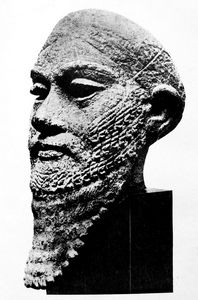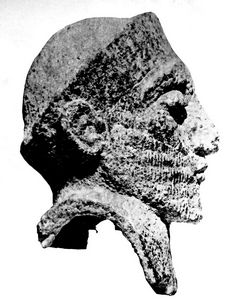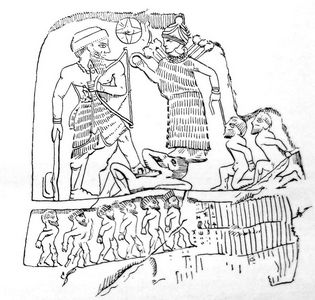EARLY STATE FORMATIONS
In III-II millenniums B.C., first tribal confederacies emerged in the southern and northern parts of Azerbaijan. In Sumero-Akkadian cuneiforms there is information on ethno-political unions of Gutians, Lullubis, Su’s and Turukkaeans which had existed in Southern Azerbaijan. In the second half of III millennium, early state formations had been formed by Lullubi and Gutian confederacies.
GUTIANS
Tribal confederacy of Gutians emerged in the area of Urmia lake in XXIV-XXIII centuries B.C. Territories inhabited by these tribes were named as Gutian state. Confederacy was formed on the southern and eastern shores of Urmia lake.
At the end of XXIII century B.C., the state had reached peak of its strength. Known as bellicose tribes with large number of population, Gutians invaded Mesopotamia and defeated Akkadian armies. On the occasion of this victory, Gutian ruler Endirdavazir (Erridupizir) had ordered a royal inscription, on which he declared himself "King of Guti, King of the Four Quarters".
Gutian rule of Mesopotamia had lasted for 91 years and covered the period of 2195-2104 B.C. There are names of 21 Gutian rulers inscribed on Sumer cuneiforms.
LULLUBIS
Another ethno-political union in the territory of Azerbaijan was Lullubian tribal confederacy established in the second half of III millennium B.C. Lullubis had been first mentioned on the Akkadian steles, commemorating the name of “Sidurru – king who united Lullubum mountaineers under his rule”. Lullubian confederacy emerged in the basin of Urmia lake. Lullubis used to live in the area between the upper reaches of Tigris and the southern shore of Urmia, to the east and south of Gutian tribes.
Name of Lullubian king Anubanini had been mentioned on XXII century Behistun Inscription written in Akkadian script and language: “Anubanini, the mighty king, king of Lullubum, erected an image of himself and an image of Ishtar in the Mountains of Batir”. Lullubis played important role in the regional policy for around 1500 years.
Gutian and Lullubian confederacies fell into decay at the end of III century B.C.
TURUKKAEANS
Among tribes living in the territory of Southern Azerbaijan there also was a confederacy named Turukkaeans which had been formed at the same time as Gutian and Lullubian unions. Sources of the second half of III millennium B.C. regard Turukkaeans as allies of both Gutian and Lullubian confederacies.
Throughout the course of XVIII century B.C., there had been several wars between Turukkaeans and Assyrian forces. Mari letters mention Turukkaean ruler Lidayan who led struggle of his people against Assyrian troops. At that time, Turukkaeans had been a key force to prevent Assyrians from conquering territories to the east of Tigris.
SU, SUBIS
In Sumero-Akkadian cuneiforms of late III millennium B.C., there is an information on the “Land of the people of Su” which existed in the Urmia basin. In 2003 B.C., Subis and Elamites had formed an alliance against 3rd Dynasty of Ur and held successful military campaign.
As stated by a script of the Assyrian king Sargon II, Subis played role in the formation of Mannean people: “… People of Urartu called Subis as Manneans”.
In XIV-XIII centuries B.C., Gutian, Lullubian, Turukkaean and Subian people had been allies in their common fight against Assyrian Empire. All these tribes played important role in the ancient history of Azerbaijan. Mannean people which had formed a state at the beginning of I millennium B.C., are known as the successors of these tribal unions.



